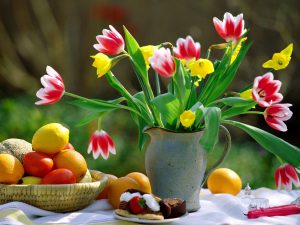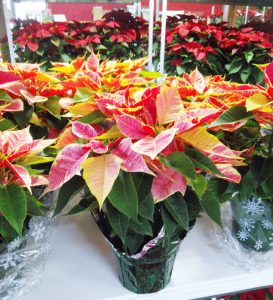Sept 22nd -Dec 21st
 It’s harvest time! Root crops like pumpkins, potatoes (including sweet potatoes), carrots and onions are ready to be enjoyed. Some crops (carrots) will survive a light frost and can remain in the soil. Monitor other cool weather crops (like cabbage, spinach) until they are ready. Green tomatoes should be harvested and brought indoors before frost.
It’s harvest time! Root crops like pumpkins, potatoes (including sweet potatoes), carrots and onions are ready to be enjoyed. Some crops (carrots) will survive a light frost and can remain in the soil. Monitor other cool weather crops (like cabbage, spinach) until they are ready. Green tomatoes should be harvested and brought indoors before frost.
Keep watering trees and shrubs, most importantly, the younger ones, unless there is plenty of rain each week. Plants need about an inch of rain every week. Well-watered plants will survive the winter better. Keep watering until the ground is frozen.
Plant spring-flowering bulbs like tulips, hyacinths, crocus, daffodils. Selecting larger (more mature) bulbs will result in larger flowers. (Not ready to plant those bulbs you bought? Simply store them in a cool, dry and preferably dark location. Do not store them with fresh fruit or vegetables in the refrigerator.)
When fall colors begin to transform the landscape, it’s a good time to transplant small trees and shrubs.
Fall is a great time to plant new trees and shrubs, allowing them plenty of still fairly warm weather to get established before icy winter temperatures arrive. Be sure to stake young, newly planted trees for support. Where rabbits or deer are common, tree guards will keep the animals from gnawing on the trees’ trunks.
Clean out dry leaves and debris to avoid passing natural sugars into the root systems of the grass and trees.
Give yourself a break: Instead of raking leaves, simply mow over them a couple times.
Fertilize the lawn in late Fall.
Cover the soil around plants, shrubs and trees with mulch/compost.
To wrap or not to wrap? Actually, most evergreens which are established and hardy in your area do not need to be wrapped for protection in winter. Some, however, get “winter burn,” as do some very young, newly planted trees that have not yet rooted into the underground moisture system. Check with our nursery’s customer service staff for expert advice on burlap wrap, mulching and more.
Inventory your lawn and garden supplies to make sure you have garden cloth to cover plants during an early frost, rakes, leaf bags, etc.
Make necessary repairs and adjustments as needed to flower beds, trellises.
Tip: When removing or cutting down dried flowers and plants before Winter, leave the ones that have seed heads (ornamental grasses and some perennials) so the birds will have food during the cold months.
Winter
Dec 21st – March 20th

Rest, relax and enjoy the satisfaction of completing a full and rewarding gardening season.
Plan for future gardening: Make a paper or computer plan of your garden or yard. Do it in color for greater enjoyment and better planning. Gardening books and magazines can guide you and inspire you – and so can the Sanders customer service staff. Just visit our nursery to envision all the spectacular and functional possibilities!
Spring
March 20th – June 20th
Winter clean-up: Rake and clear out dried leaves, dead growth and debris from around shrubs and trees and the lawn.
Lightly rake up patches of lawn that may be dead, and re-seed them. Keep the new seed watered.
Check the lawn mower. Is it ready for that heavy duty mowing season soon to come? Get the blades sharpened.
If you’re adventurous, try growing flowers and vegetables from seeds. This is especially fun for plants that bloom or mature in late Spring and Summer. Best conditions are: Indoors under fluorescent lights or in a warm, sunny greenhouse, about eight or nine weeks before the anticipated last frost of winte
r. (Instructions for spacing, watering, location, etc., are readily available on labels, seed packets and from any of our customer service representatives.)
For cooler weather veggies like cabbage, radishes and broccoli, plant seedlings (young plants already grown to a height and condition suitable for planting) outside.
Spring is an ideal time to transplant shrubs. Do this before they begin to leaf out.
While they are still dormant, treat fruit trees and shrubs (like Euonymus) to protect them against scale insects and pests that hung on through winter. A good organic oil spray should be applied after the last frost but before the leaves have opened.
Plant shrubs and trees during mid-Spring. Keep them well watered, watering them if drought conditions exist or rain is rare.
trees during mid-Spring. Keep them well watered, watering them if drought conditions exist or rain is rare.
Add mulch under shrubs and flower beds where weeds could become problematic, and to keep soil moist.
Plant summer flowering bulbs like lilies, gladiolus, after all danger of frost is over. Label new plants for easy reference.
Install support stakes for gladiolus, delphiniums and peonies while they are still at a manageable height.
Divide and replant perennial flowers that have been in the soil for a couple years or more.
To prepare for warm weather planting, till the soil at least six inches deep. If recommended, add a soil enhancement product such as organic material or fertilizer.
Between Spring rains is a perfect time to install a trellis or a watering system, build flower beds and perform maintenance.
Lawn care includes aerating your lawn and controlling weeds. Set the mower blades to about three inches’ height.
Summer
June 20th – Sept 22nd
 The growth of cool-weather vegetables will begin to slow as the ambient temperature rises, and that’s a clue that it’s time to pull out their vines and harvest them. Keep them picked to stimulate them to produce more.
The growth of cool-weather vegetables will begin to slow as the ambient temperature rises, and that’s a clue that it’s time to pull out their vines and harvest them. Keep them picked to stimulate them to produce more.
Turn the soil and plant flowers, shrubs and vegetables that thrive and bloom in warm weather. If you’re not growing from seed, pick up some of our high quality bedding plants.
Cut down the dead and yellowed leaves of spring flowers no longer in bloom.
Some shrubs, such as crapemyrtle and nandina) adore hot weather, require minimal watering and add beauty wherever they are planted. Crapemyrtle can be planted most any time of year.
Check plants for insects and take steps to eliminate them. Check with our customer service staff for advice on the most effective products.
If you’re fond of growing from seed, Summer is the time to begin the seed garden for plants that will bloom/mature in the Fall.
Mulch can be used to great results in summer as well as winter. Cover the soil to retain moisture and protect the plants from extreme heat.
Deadhead (remove dead flowers) geraniums, lilacs, roses, rhododendrons and most flowers, to keep them flowering. Pinch back chrysanthemums and asters so they will produce a fuller, more bushy look.
Spray roses with a fungicide weekly.
Water the plants at least one inch each week. Increase to twice weekly if the weather is exceptionally hot. In Oklahoma’s extreme heat (two or three consecutive weeks of temperatures over 100 degrees Fahrenheit), watering may be required every other day or even daily. Monitor the plants closely.
Although most trees and shrubs regain their healthy appearance after a good rain and a little cooler weather arrives, you can help keep them healthy by covering the more delicate shrubs and vegetables with a light fabric or garden cloth to protect them from sunburn and drying out.
Lawn mowing should be done as often as necessary. Don’t remove more than one third of the grass blades; leave about three inches’ height, especially in hot weather.
Keep notes on what works, what needs changing and what doesn’t work. What flowers simply don’t thrive in your climate or your garden? What colors are missing? Your notes will be much appreciated in the winter months as you plan the next year’s garden.






 The fastest way to get that deep layer of fertile soil is to make raised beds. Raised beds yield up to four times more than the same amount of space planted in rows. That’s due not only to their loose, fertile soil but also to efficient spacing—by using less space for paths, you have more room to grow plants.
The fastest way to get that deep layer of fertile soil is to make raised beds. Raised beds yield up to four times more than the same amount of space planted in rows. That’s due not only to their loose, fertile soil but also to efficient spacing—by using less space for paths, you have more room to grow plants.





